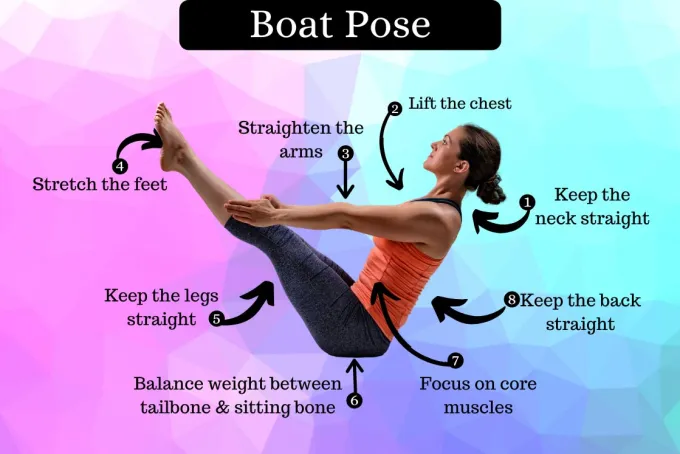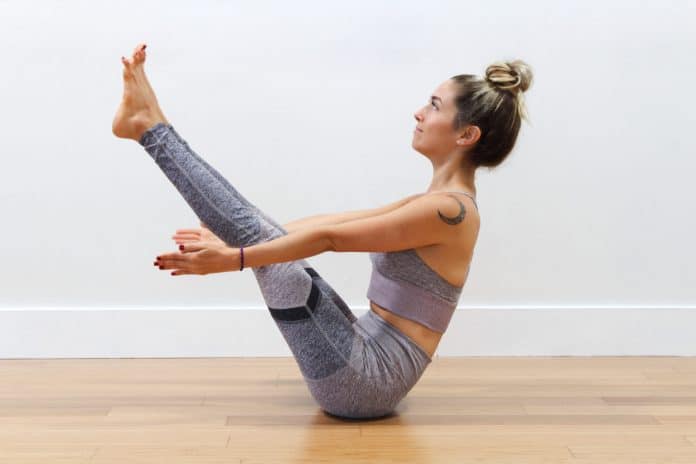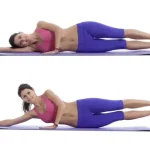Boat Pose is a great posture for strengthening the core and toning the back and abdominal muscles. It is a straightforward forward-balancing bend. Your tailbone and sitting bones must support the weight of your entire body in this position.
Although fairly difficult, this pose has several health advantages for the body. It works the muscles in the back, hips, thighs, and core, making them stronger and more flexible.
Navasana, or Boat Pose, gets its name from the way the body is positioned in it: it resembles a boat (Nava). While doing this asana, our bodies create a shape that resembles a “V.”
| Pronunciation | Nah-Vah-Sana |
| Meaning | Nava – Boat Asana – Pose |
| Known as | Complete Boat Pose, Paripurna Navasana, Naukasana, Navasana |
| Pose Type | Sitting, balancing & forward-bend |
| Pose Level | Intermediate, hold for 10-60 seconds |
| Beneficial In | Strengthening core and lower back muscles |
Considering losing belly fat or putting in a lot of effort to get abs? Yoga can benefit you!
Numerous yoga poses, or “asanas,” can help you lose belly fat. Navasana, often known as the Boat Pose, is one of these asanas and it has great belly fat-reducing and core muscle-toning properties.
How to Do Boat Pose

Navasana may appear straightforward in pictures, but it is not. Body balance requires a strong core and intense concentration. The steps to do this asana are listed below.
Steps to Perform Boat Pose
-
Preparing the Asana
1. Sit on the floor and straighten your feet flat on the floor, keeping your spine straight.
2. Your legs should now be folded, with your feet level on the floor and your knees pointing up.
Note- You have to bring your legs together, feet and knees of both legs touching each other.
-
Getting Into the Asana
- Draw your shoulder back now, and tilt your torso back slightly. Lift the feet off the ground while exhaling, distributing your weight evenly between your tailbone and sitting bones. The chest should be elevated while keeping the shins parallel to the ground.
This is the Half Boat Pose
Note- You can take the support of the hands, by grabbing the thighs, to maintain balance.
4. Now slowly straighten your legs such that they are at an angle of 20 to 45 degrees with the ground. The toes should be pointing forward when stretching the feet. Keep your back straight and your legs from spreading out.
5. Raise your arms parallel to the floor, straight and at shoulder height. Fingers will be pointing forward with the palm facing the thighs.
Here your body will look like the letter ‘V.’
Note: You can also position your hands with both palms facing inward, parallel to your lifted legs, with your fingers pointing down at your toes.
6. Start breathing normally now, holding this position for 5-8 breaths (around 20-60 seconds).
-
Releasing the Pose
7. Bring your legs down slowly once you’re finished. If necessary, you can use your arms as support.
8. Now settle into a seat and let your body relax.
Beginner’s Tips
Boat Pose is an asana that you can do with the following adjustments if you find it difficult at first.
Take your hands as support. While practicing this asana, you can lean on your hands for support. Simply softly grip the lower thighs with your palms. You can keep your balance and retain good posture by doing this.
Try it without gripping the thighs once you’ve practiced it a bit.
Employ the props. In the beginning, you can use a yoga strap to assist in Navasana. Simply wrap it around your soles and hold it in place with your hands while maintaining a straight back, arms, and legs.
Lean less. It’s acceptable if you can’t maintain the stance for a lengthy time at first. Simply hold the position for 1-3 breaths (around 5-15 seconds). After some practice, progressively raise it.
Get а Partner’s Assistance. When practicing this pose for the first time, teaming up with someone or asking for assistance from someone can be quite helpful. In the beginning, you can seek assistance from a buddy or a yoga instructor.
Precautions and Contraindications
The following considerations must be made while performing Navasana.
1. Do not round your back, as was previously mentioned. Keep your back straight since bending it will take all the attention away from it.
2. Practice this pose gently and slowly. It should not be completed quickly. This pose tightens the muscles in your stomach, therefore if it is done wrong, it might hurt your core muscles.
3. Do not execute this asana if you have a deep or recent injury to your lower back, hips, thighs, or abdomen. Due to the fact that Boat Pose primarily targets these muscles, doing it while injured will have negative repercussions.
4. This pose should not be done by anyone with high or low blood pressure, a headache, or a migraine.
5. Boat Pose can be hazardous during a woman’s menstrual cycle because it exerts pressure on the lower abdomen and lower back. As a result, women should avoid it during their periods.
Navasana Science Behind Boat Pose
Navasana bolsters the muscles in the back, hips, thighs, and core. Let’s examine the science of the Boat Pose and how it functions.
First and foremost, and this is the most crucial aspect of practicing Navasana, this pose puts a lot of effort into the muscles in the core. Additionally, the middle back and lower back are simultaneously affected by pressure. The muscles in these places are toned by this pressure.
The thigh muscles are then firmed and toned by this asana. Additionally, our hip supports and balances the entire weight while receiving a wonderful massage and toning.
Benefits of Boat Pose
- The core muscles are worked in the boat position, which improves their strength and flexibility. It strengthens the muscles in the core. In other words, it helps to provide the core with fantastic shape and to build the abs.
- The abdominal muscles and organs are toned by this pose. It massages the digestive tract, liver, and other internal organs like the kidneys. As a result, it promotes improved digestion and boosts the body’s metabolism.
- Navaasana burns extra fat that has been stored in the back and core by using these muscles. Additionally, it aids in reducing extra fat-related weight.
- This pose puts just the appropriate amount of pressure on the back muscles, particularly those in the lower back. These muscles are strengthened by pressure, which works like an exercise. The Boat Pose maintains the back’s health, increases its flexibility, and shields it against back issues.
- In Navasana, the muscles of the hips, thighs, core, and back are primarily toned and massaged. This massage improves relaxation while easing tension and stress that has built up in certain areas.
Additionally, the hips balance the body’s weight by taking all of it there. As a result, the hips become stronger, more flexible, and more relaxed thanks to this weight.
- This asana requires exercise, which enhances blood circulation throughout the body. This maintains both our physical and emotional well-being. Additionally, it aids in reducing depression, exhaustion, and sleeplessness, which in turn aids in improving your mood.





















